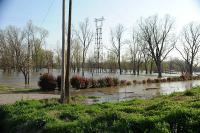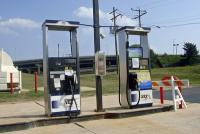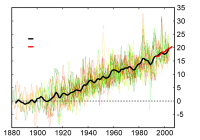-
Successful tests may lead to faster creation of new nuclear fuels
Idaho National Laboratory recently completed the first successful test of fabrication equipment in the Experimental Fuels Facility (EFF) at INL’s Materials and Fuels Complex. Specifically, they finished the first extrusions of depleted uranium — a process of shaping material by forcing it through a die. The test serves to restore a metallic fuel fabrication capability that has not been used in the United States since the 1980s.
-
-
Helping replenish groundwater by flooding farms in the winter

California is in chronic groundwater overdraft: There is more water being pumped from the ground than filtering in, and the state’s aquifers are shrinking as more growers pump groundwater to keep crops alive. But that fertile farmland may also provide the means for replenishing groundwater to benefit everyone in the drought-stricken state. Researchers at the University of California, Davis, are encouraged by early results from tests to see whether deliberately flooding farmland in winter can replenish aquifers without harming crops or affecting drinking water.
-
-
Rising seas, bigger storms may greatly magnify U.S. East Coast floods
Over the past century, the East Coast has seen sea-level rise far above the 8-inch global average — up to a foot in much of the Mid-Atlantic and Northeast, including New York City. Many studies predict that future sea-level rise along the U.S. Atlantic and Gulf coasts will increase flooding. Others suggest that the human-caused warming driving this rise will also boost the intensity and frequency of big coastal storms. Up to now, though, these two hazards have been assessed mostly in isolation from each other. Now, a new study quantifies how they could interact to produce alarming spikes in the combined height and duration of flooding. It projects that coastal flooding could possibly shoot up several hundredfold by 2100, from the Northeast to Texas.
-
-
El Niño, La Niña will exacerbate coastal hazards across entire Pacific
The projected upsurge of severe El Niño and La Niña events will cause an increase in storm events leading to extreme coastal flooding and erosion in populated regions across the Pacific Ocean, according to a multi-agency study. The impact of these storms is not presently included in most studies on future coastal vulnerability, which look primarily at sea level rise. New research data, from forty-eight beaches across three continents and five countries bordering the Pacific Ocean, suggest the predicted increase will exacerbate coastal erosion irrespective of sea level rise affecting the region.
-
-
Grid Game teaches students about electric grid complexity, resilience
Outages caused by severe weather cost the U.S. economy an average of $18 billion to $33 billion a year. The hits come from lost output and wages, spoiled inventory, delayed production, and damage to the electric grid. Engineers and teachers have developed a Grid Games — desktop simulation which allows players to keep load and generation in balance. “Red Team” participants can even mount financial and cyberattacks in real time, making the game even more interesting.
-
-
Cost of coal greater than it seems
The cost of coal use is greater than it seems and policies geared toward subsidizing its use must be reformed quickly, before countries invest in coal-fired plants, a new study says. Governments around the world heavily subsidize fossil fuels, and in 2013 pretax subsidies amounted to about $550 billion worldwide. These substantial subsidies not only drain funds that could be used for other purposes, such as sanitation and poverty reduction, but discourage investments in low-carbon alternatives.
-
-
Rather food versus fuel, think in terms of both food and fuel

Whether you have taken a side or a backseat in the discussion, the “food versus fuel” debate affects us all. Some say growing more biofuel crops today will decrease greenhouse gas emissions, but will make it harder to produce food tomorrow, which has prevented the United States from maximizing the potential of environmentally beneficial biofuels. Scientists argue that farmers can sustainably, and affordably, meet humanity’s growing demand for food and fuel.
-
-
Snowpack of Sierra Nevada lowest in 500 years, worsening California water woes

Snowpack in California’s Sierra Nevada in 2015 was at the lowest level in the past 500 years, according to a new report. “Our study really points to the extreme character of the 2014-15 winter. This is not just unprecedented over 80 years — it’s unprecedented over 500 years,” said the lead author of the report. On 1 April of this year, California Governor Jerry Brown declared the first-ever mandatory water restrictions throughout the state while standing on dry ground at 6,800-foot elevation in the Sierra Nevada. The historical average snowpack on that site is more than five feet, according to the California Department of Water Resources.
-
-
Burning world’s remaining fossil fuel could cause 60-meter sea level rise

New work from an international team including Carnegie’s Ken Caldeira demonstrates that the planet’s remaining fossil fuel resources would be sufficient to melt nearly all of Antarctica if burned, leading to a 50- or 60-meter (160- to 200-foot) rise in sea level. Because so many major cities are at or near sea level, this would put many highly populated areas where more than a billion people live under water, including New York City and Washington, D.C. The researchers found that if global warming did not exceed the 2 degree Celsius target often cited by climate policymakers, Antarctic melting would cause sea levels to rise only a few meters and remain manageable. But greater warming could reshape the East and West ice sheets irreparably, with every additional tenth of a degree increasing the risk of total and irreversible Antarctic ice loss.
-
-
Beyond data theft: Next phase of cyber intrusions will include destruction, manipulation of data
James Clapper, director of U.S. intelligence, and other senior intelligence officers, have warned Congress that the next phase of escalating online data theft will likely involve the manipulation of digital information. Clapper on Wednesday told lawmakers on the House Intelligence Committee that a “cyber Armageddon,” in which a digitally triggered damage to physical infrastructure results in a series of catastrophic events, is less likely than “cyber operations that will change or manipulate data.” Leaders of the U.S. intelligence community told lawmakers that the manipulation or destruction of data would undermine confidence in data stored on or accessible through U.S. networks, engendering an uncertainty which could jeopardize U.S. military situational awareness and undermine business activity.
-
-
Pipeline replacement programs are effective
Aging infrastructure, including roads, bridges, and natural gas and water mains, is an increasing concern. In 2011 the U.S. Pipeline and Hazardous Materials Safety Administration issued a call to action to accelerate the repair, rehabilitation, and replacement of the highest-risk pipeline infrastructure. Invisible gas leaks from aging or damaged pipelines cost U.S. consumers billions of dollars every year, contribute to global warming and, in rare cases, cause dangerous explosions. Pipeline replacement programs in cities, however, can cut natural gas leaks by 90 percent, a new study finds. “The surprise wasn’t that replacement programs worked,” said the study’s lead author. “It was that they worked so well.”
-
-
Innovative method filters seawater in minutes
Researchers have unveiled a cost-effective desalination technology which can filter highly salty water in minutes. The technology is based on membranes containing cellulose acetate powder, produced in Egypt. The powder, in combination with other components, binds the salt particles as they pass through, making the technique useful for desalinating seawater.
-
-
NOAA: El Niño may accelerate nuisance flooding
Nuisance flooding causes public inconveniences such as frequent road closures, overwhelmed storm water systems, and compromised infrastructure. The extent of nuisance flooding depends on multiple factors, including topography and land cover. According to a new NOAA report issued yesterday, many mid-Atlantic and West Coast communities could see the highest number of nuisance flooding days on record through April due to higher sea levels and more frequent storm surge, compounded by the strengthening El Niño, which is likely to continue into the spring. These communities may experience a 33 to 125 percent increase in the number of nuisance flooding days, the report said.
-
-
Army Corps of Engineers risk reduction projects prevent $13.3 billion in flood damages
May 2015 was the wettest month on record for both Texas and Oklahoma, and set numerous records throughout the region. Continuing rains from Tropical Storm Bill in June resulted in Army Corps of Engineers flood risk reduction reservoirs and other systems put through a rigorous test to hold the floodwaters and protect local communities and downstream areas. According to recent calculations by U.S. Army Corps of Engineers officials with the Southwestern Division in Dallas, the Corps flood risk reduction projects in the south central and southwestern United States prevented an estimated $13.3 billion in damages to local communities and infrastructure during the May-June 2015 flood event.
-
-
2015 drought costs for California agriculture: Loss of $1.84 billion, 10,100 jobs

The drought is tightening its grip on California agriculture, squeezing about 30 percent more workers and cropland out of production than in 2014, according to the latest drought impact report. In 2015, the state’s agricultural economy will lose about $1.84 billion and 10,100 seasonal jobs because of the drought, the report estimated, with the Central Valley hardest hit. The heavy reliance on groundwater comes at ever-increasing energy costs as farmers pump deeper and drill more wells. Some of the heavy pumping is in basins already in severe overdraft — where groundwater use greatly exceeds replenishment of aquifers — inviting further land subsidence, water quality problems, and diminishing reserves needed for future droughts.
-
More headlines
The long view
Helping Strengthen America’s Critical Infrastructure
Everyday life depends on a robust infrastructure network that provides access to running water, communications technology and electricity, among other basic necessities. The experts who keep our national infrastructure secure and resilient also need a strong network to share their knowledge and train the next generation of professionals capable of solving complex infrastructure challenges.
AI and the Future of the U.S. Electric Grid
Despite its age, the U.S. electric grid remains one of the great workhorses of modern life. Whether it can maintain that performance over the next few years may determine how well the U.S. competes in an AI-driven world.
Using Liquid Air for Grid-Scale Energy Storage
New research finds liquid air energy storage could be the lowest-cost option for ensuring a continuous power supply on a future grid dominated by carbon-free but intermittent sources of electricity.
Enhanced Geothermal Systems: A Promising Source of Round-the-Clock Energy
With its capacity to provide 24/7 power, many are warming up to the prospect of geothermal energy. Scientists are currently working to advance human-made reservoirs in Earth’s deep subsurface to stimulate the activity that exists within natural geothermal systems.
Experts Discuss Geothermal Potential
Geothermal energy harnesses the heat from within Earth—the term comes from the Greek words geo (earth) and therme (heat). It is an energy source that has the potential to power all our energy needs for billions of years.
